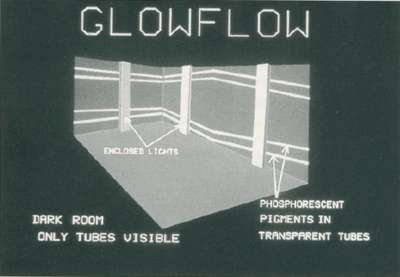GLOWFLOW was a computer-controlled light-sound environment. It was a computer art project conceived by Dan Sandin, Jerry Erdman, and Richard Venezsky; and exhibited at the Memorial Union Gallery of the University of Wisconsin in April 1969.
The installation consisted of a dark room in “which glowing lines of light defined an illusory space. The display was accomplished by pumping phosphorescent particles through transparent tubes attached to the gallery walls. These tubes passed through opaque columns concealing lights which excited the phosphors. A pressure sensitive pad in front of each of the six columns enabled the computer to respond to footsteps by lighting different tubes or changing the sounds generated by a Moog synthesizer or the origin of these sounds. […] Delays were introduced between the detection of a participant and the computer’s response so that the contemplative mood of the environment would not be destroyed by frantic attempts to elicit more responses.” [Krueger 1977]


